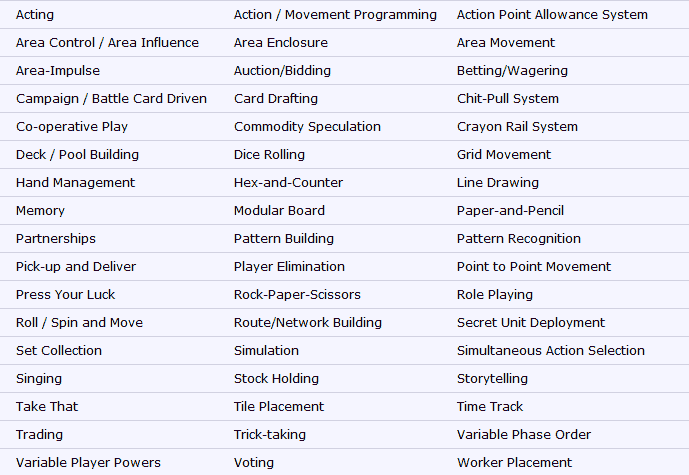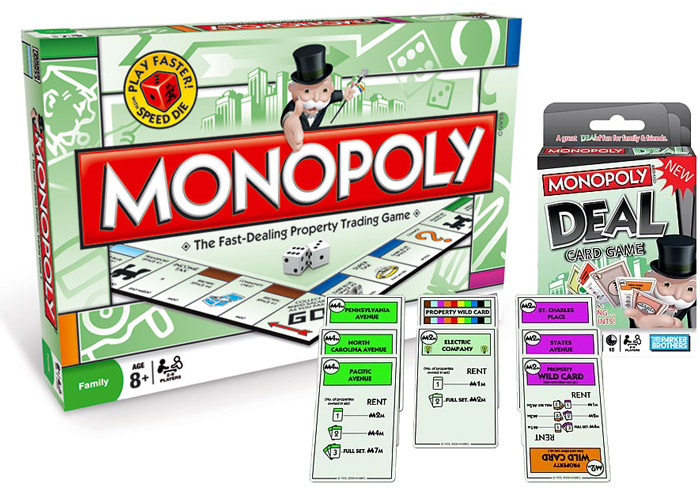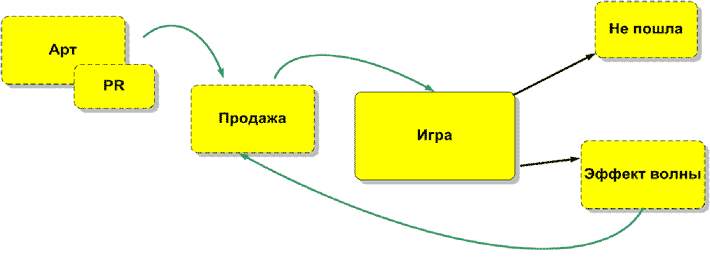Game mechanics: let's look at the core of the game by bone
The term "game mechanics" has many meanings, but today I will speak of game mechanics as an abstraction defining the state of the game. Very simplistic, it looks like this:

There are only two factors that determine any current state of the game: the mechanics (rules) and the players by their actions.
')
Tact 1: state determination
There is always a certain current state of the system (for example, the beginning of the turn). It is determined on the first cycle by the initialization sequence, when players “load” the game, spreading out the field, choosing chips, distributing initial resources, and so on. Then it changes depending on what is happening in the game.
Tact 2: players evaluate the state for decision making
After updating the state of the game there is a tact during which players make decisions based on new information.
Tact 3: players perform actions
At this step, players change the state of the game, doing something in accordance with the rules, for example, moving a piece.
Tact 4: the game itself gives feedback
In chess, there is no such thing, but, for example, if we played dice, the game would generate us some random numbers on the dice for the new state.
The exit from the cycle is done according to one of the criteria for ending the algorithm, that is, for example, your victory.
Once again: based on the state analysis, the players decide on their actions, perform these actions, interact with other players and rules, and then set the game to a new state. The game can do some of the work itself, regardless of the actions of the players. For example, in a Startup, each turn opens a card with a random event.
Game mechanics consists of a kind of genes - known sequences of actions, which are not very many. New genes appear in the desktop world only a couple of times a year, and not all take root. This is what the current BGG version list looks like (this is a rather conditional division, since the classification is not very clear):

For example, Monopoly is a combination of mechanics of stakes, “roll the dice and move”, collection of a set and trades. At the level of the setting, you buy real estate and compete, at the level of mechanics, you move around the field, collect sets of cards and make bets with chips.
Without mechanics, it would be unclear how to trade in real estate - the mechanics reduced it to manipulation with bids and cards, and the players presented everything else on other levels.
Mechanics is almost always an abstraction, not related to the game setting and the plot. For example, in the board game “Game of Thrones” it doesn’t matter who and what walks. You can absolutely calmly from the “Game of Thrones” make a game about the Great Patriotic War.

Tabletop Angry Birds - this is the evolution of towns. General mechanics - throwing objects. Excellent mechanics for this particular setting. In the first case, it is necessary to bat in the chocks, in the second - birds for pigs. The first game costs 350 rubles, the second is more than 1000. The mechanics are the same, but the setting is different - and guess what sells better.
When mechanics are combined with the setting, it works much better. For example, in the “Space truckers” a meteorite that came to the open gateway to the left is the destruction of a module. It is easy to imagine and easy to perform, without looking at the rules.
Therefore, an important principle of good mechanics is the correspondence of the actions that it dictates to what players expect on this occasion.
Obviously, the setting is very helpful in explaining mechanics and its natural interaction with the user. For example, "Jackal" is actually a game about a weighted count, but players go around the island and are looking for treasure. From the point of view of mechanics, the coincidence of the coordinates of the figures leads to the destruction of one of them and the creation of a new object at a given point, and from the player’s point of view, one pirate hits the other, and the victim returns to his ship. If the mechanics at the same time created two pirates on the ship, it would be extremely difficult to explain in the setting why this is so - and some other interface would be required.
Yes, you understood correctly: the realistic nature of actions within the setting depends on the mechanics. For example, you can play an economic simulator of the exchange with all the difficulties, and you can issue the same game about the exchange in the form of mechanics "roll the cube and slide the chip." It is clear that the second option is not what you expect from an economic simulator.

The same setting for different mechanics: a game with a field and another game on the maps
Another important thing is that mechanics creates a common language of rules to which game events obey. However, it introduces limitations in the model, which are not always good.
We play to have fun. It can be obtained from the game itself, making decisions in its process, communicating with other players, contemplating art (as in the Imaginarium), winning and heaps of other things. Here are some details .
The most important thing in mechanics is the definition of the “high point” . Roughly speaking, these are the actions that cause the player a chemical reaction of the body. Simply put - that the player will be happy to repeat and repeat again (this is the essence of the game - to have fun). Obviously, any point of buzz should lie outside the game - otherwise there would simply be no point in this game.
Some children's games are boring and incomprehensible for adults. The fact is that small children can simply go wild from the process of finding pictures in a heap, moving off and moving objects, and so on. Their pleasure can even lie in motility: the child likes to do something small, which immediately seriously changes the state of the game (as he understands that he can influence the world around him). For example, the fall of a wooden tower of bars in Djenga is a real miracle, causing a heap of screeching.
The average player loves to see his impact on the game. In cooperative board games, players cut against the "playing field", for example, trying to overwhelm the boss for a limited number of moves.
If there are three players, one of them can easily fall out of the decision-making process: in fact, a strong leader will steer his chip. This is important for family games, where the mother does not really want to understand the game, but simply wants to see her son at the table, near, with burning eyes and without a computer. But this is bad for games that are designed specifically for normal players. Therefore, it is good if each of the players at least once per game can make a decision that will affect the situation as a whole.
Players do not always like to play hardcore and seriously, so if such a decision point lies too early, for example, in the first moves, the mistake will lead to lost time and frustration. If the decision point lies at the end of the game, for example, on the last move, then you can safely throw out all the previous ones. Therefore, there are usually several solutions, say, 2-3-7 per game, and each of them advances to victory. And it also helps to forgive some mistakes of the players.
Quite often, we test games, and one of the most frequent mistakes of almost all novice authors (like ours once) is an unnecessary complication, and in most cases for the sake of detailing the world and setting.
As I said, in Half-Life, you are unlikely to ever untie the laces, take off your shoes from your feet and move your fingers so that they can rest. But a person (and we after all think that we play for a person!) Can do so. And developers can decide what to add to this feature. And another hundred others just in case. How it will end is easy to imagine. Therefore, the task is to identify moments that bring one or another pleasure to the players, and then ruthlessly cut out the others that do not lead directly to the points of the high.
Now back to the question of the load on the player’s resources (time and attention). From the point of view of attention, there must be a fairly clear locus: the main sequence that needs to be monitored.
When a mechanic helps to intuitively do basic actions, the locus is moved not to implement the rules, but to make decisions. And even later - to think about the strategy as a whole. It's like driving: first, the manual gearbox will be your main enemy, and later you will learn to control it on autopilot and watch the road.
The simplest question of analyzing the attentional resource is “How many times to think and how many times to solve?”. For example, seeing three moves of opponents, you will have to think three times about what each of them has in mind. You have to decide only once - where to send your army, for example.
It is also useful to consider uptime , that is, the time when the player does something. A common mistake is a strategy with long turns, when another player sits and looks (that is, nothing changes in his picture of the world). There are examples of working games with wild downtime - large-scale strategies such as "Twilight Empire", where waiting for the end of the course of other players is brightened by the possibility of negotiating alliances. Another example is the same “Game of Thrones”, where players make moves at the same time, and then just rezolvity stack orders: instead of the N-1 periods of downtime for N players, the game designer made only one, but a little longer than the standard. Damn beautiful.
The next question is how mechanics relate to the growth of player experience. For example, in chess only the player’s experience decides. In Russian roulette experience does not solve at all.
If the game is aimed at the middle segment, you can do this:
The success or failure of the game is largely determined by how it delays the players. Let's look at 3 computer games:
The most important thing for the success of the game (that is, sales) is the adjustment to the audience.

The same setting and almost the same mechanics with different art (setting for adults with painted art and players with 3D children):
Here are the questions, the answers to which need to be understood before the final sharpening:
Most of the mechanic has direct analogues in platform games. Moreover, as a rule, the “buzz points” of board games are so strongly emphasized that even a simple porting of the game allows it to be hit. In Appstore, for example, there are an incredibly many nastol:

As was shown by the example of Angry Birds, some computer games and applications for tablet phones are also transferred to the desktop format. For example, there are “ports” of Starcraft, MOO, Warcraft, Civilization, Doom, and so on.
The players at the end of the game evaluate for themselves: “Was that cool?”. If so, then you can continue to play and you can tell others about this desktop.

Accordingly, the mechanics become important not for sale in the store and not for the game announcement stage (here art and marketing decide more), but for sales after the first thousand copies, when people who have played will already come to the stores for new boxes.
Mechanics determine the "virality" of the game more than art, plot, atmosphere, setting details, and so on, and this is what is important for experienced players.
Phew If you read it, thanks. Not really wanted to write such a long topic, but promised.

There are only two factors that determine any current state of the game: the mechanics (rules) and the players by their actions.
')
Core level
Tact 1: state determination
There is always a certain current state of the system (for example, the beginning of the turn). It is determined on the first cycle by the initialization sequence, when players “load” the game, spreading out the field, choosing chips, distributing initial resources, and so on. Then it changes depending on what is happening in the game.
Chess status
In chess, we always have the position of pieces on the board and it is always known whose turn is now. The initial arrangement of the figures is determined by the rules of the game, all other states - by how the players will move their pieces. Only those states that are achievable subject to the rules. An example of a mistake is 5 kings on the board.
Tact 2: players evaluate the state for decision making
After updating the state of the game there is a tact during which players make decisions based on new information.
Tact 3: players perform actions
At this step, players change the state of the game, doing something in accordance with the rules, for example, moving a piece.
Tact 4: the game itself gives feedback
In chess, there is no such thing, but, for example, if we played dice, the game would generate us some random numbers on the dice for the new state.
The exit from the cycle is done according to one of the criteria for ending the algorithm, that is, for example, your victory.
Once again: based on the state analysis, the players decide on their actions, perform these actions, interact with other players and rules, and then set the game to a new state. The game can do some of the work itself, regardless of the actions of the players. For example, in a Startup, each turn opens a card with a random event.
"SDK"
Game mechanics consists of a kind of genes - known sequences of actions, which are not very many. New genes appear in the desktop world only a couple of times a year, and not all take root. This is what the current BGG version list looks like (this is a rather conditional division, since the classification is not very clear):

For example, Monopoly is a combination of mechanics of stakes, “roll the dice and move”, collection of a set and trades. At the level of the setting, you buy real estate and compete, at the level of mechanics, you move around the field, collect sets of cards and make bets with chips.
Without mechanics, it would be unclear how to trade in real estate - the mechanics reduced it to manipulation with bids and cards, and the players presented everything else on other levels.
Mechanics is almost always an abstraction, not related to the game setting and the plot. For example, in the board game “Game of Thrones” it doesn’t matter who and what walks. You can absolutely calmly from the “Game of Thrones” make a game about the Great Patriotic War.

Tabletop Angry Birds - this is the evolution of towns. General mechanics - throwing objects. Excellent mechanics for this particular setting. In the first case, it is necessary to bat in the chocks, in the second - birds for pigs. The first game costs 350 rubles, the second is more than 1000. The mechanics are the same, but the setting is different - and guess what sells better.
"GUI"
When mechanics are combined with the setting, it works much better. For example, in the “Space truckers” a meteorite that came to the open gateway to the left is the destruction of a module. It is easy to imagine and easy to perform, without looking at the rules.
Therefore, an important principle of good mechanics is the correspondence of the actions that it dictates to what players expect on this occasion.
Example
In MTG, there is a stack system of actions, and up to a certain revision combat damage was put on the stack, and then resolved. If, for example, a revocation spell in hand appears on top of the damage in the stack, players will see a situation that is strange in terms of realism:
1. Two creatures met in battle (damage went into the stack).
2. Player A played a recall (the recall spell went on the stack).
3. Player B checked.
4. The first object was cut off from the stack (player A's being returned to the hand).
5. The second object was cut off from the stack (damage by creatures, but since the first is no longer on the table - only essentially B).
It turned out that a non-existent being had already killed someone. The damage in the stack was extremely elegant from the point of view of the overall mechanics of the game, but it was difficult to explain to novice players why their creature went to the cemetery in such a situation. Therefore, the developers at some point were forced to rezolvit damage in battle past the stack, which cut off part of the depth of tactics, but improved the "interface" of the game.
1. Two creatures met in battle (damage went into the stack).
2. Player A played a recall (the recall spell went on the stack).
3. Player B checked.
4. The first object was cut off from the stack (player A's being returned to the hand).
5. The second object was cut off from the stack (damage by creatures, but since the first is no longer on the table - only essentially B).
It turned out that a non-existent being had already killed someone. The damage in the stack was extremely elegant from the point of view of the overall mechanics of the game, but it was difficult to explain to novice players why their creature went to the cemetery in such a situation. Therefore, the developers at some point were forced to rezolvit damage in battle past the stack, which cut off part of the depth of tactics, but improved the "interface" of the game.
Obviously, the setting is very helpful in explaining mechanics and its natural interaction with the user. For example, "Jackal" is actually a game about a weighted count, but players go around the island and are looking for treasure. From the point of view of mechanics, the coincidence of the coordinates of the figures leads to the destruction of one of them and the creation of a new object at a given point, and from the player’s point of view, one pirate hits the other, and the victim returns to his ship. If the mechanics at the same time created two pirates on the ship, it would be extremely difficult to explain in the setting why this is so - and some other interface would be required.
Yes, you understood correctly: the realistic nature of actions within the setting depends on the mechanics. For example, you can play an economic simulator of the exchange with all the difficulties, and you can issue the same game about the exchange in the form of mechanics "roll the cube and slide the chip." It is clear that the second option is not what you expect from an economic simulator.

The same setting for different mechanics: a game with a field and another game on the maps
Another important thing is that mechanics creates a common language of rules to which game events obey. However, it introduces limitations in the model, which are not always good.
What causes the unexpected limitation of the model
The first time when I started to play STALKER, I walked around the village for half an hour, listening to music around the fire, talking to Sidorovich and other characters. Before that, I read about megarealism - and he really shook. And then I came out of the first "peaceful" location and found the body of a stalker. And naturally carried him to the village to bury like a human being. And he didn’t give up anyone there - and I, like a fool, walked with the body and pestered NPCs, who simply didn’t change the reaction. At the same time, the game had the mechanics of carrying the body, which formed the expectation that something could be done with it. If the body could not be raised - there would be no disappointment, this is already an accepted convention.
Optimization
We play to have fun. It can be obtained from the game itself, making decisions in its process, communicating with other players, contemplating art (as in the Imaginarium), winning and heaps of other things. Here are some details .
The most important thing in mechanics is the definition of the “high point” . Roughly speaking, these are the actions that cause the player a chemical reaction of the body. Simply put - that the player will be happy to repeat and repeat again (this is the essence of the game - to have fun). Obviously, any point of buzz should lie outside the game - otherwise there would simply be no point in this game.
The points of buzz in chess
In chess, the brightest such point is the understanding of the enemy’s plan and the taking of countermeasures. You get the pleasure of unraveling your opponent’s plan and finding yourself smarter than him. The next most important point in the same place is getting an advantage on the field, for example, taking a figure. It is important that professional players are happy not just taking a figure, but a certain combination of parameters on the field. But for beginners it is important to remove the opponent's elephant from the board: here both physical action and mini-ritual turn on, and progress is evident: I have two elephants, and you already have one.
When the master of the game unexpectedly meets an equal, it will also be a high point - and this also lies beyond the limits of the game itself and mechanics. Nevertheless, the main pleasure in chess, as in all board games, is simply communication between two people. A game is something like a protocol for such communication.
When the master of the game unexpectedly meets an equal, it will also be a high point - and this also lies beyond the limits of the game itself and mechanics. Nevertheless, the main pleasure in chess, as in all board games, is simply communication between two people. A game is something like a protocol for such communication.
Some children's games are boring and incomprehensible for adults. The fact is that small children can simply go wild from the process of finding pictures in a heap, moving off and moving objects, and so on. Their pleasure can even lie in motility: the child likes to do something small, which immediately seriously changes the state of the game (as he understands that he can influence the world around him). For example, the fall of a wooden tower of bars in Djenga is a real miracle, causing a heap of screeching.
Co-op game
The average player loves to see his impact on the game. In cooperative board games, players cut against the "playing field", for example, trying to overwhelm the boss for a limited number of moves.
If there are three players, one of them can easily fall out of the decision-making process: in fact, a strong leader will steer his chip. This is important for family games, where the mother does not really want to understand the game, but simply wants to see her son at the table, near, with burning eyes and without a computer. But this is bad for games that are designed specifically for normal players. Therefore, it is good if each of the players at least once per game can make a decision that will affect the situation as a whole.
Subtle moment with balance
Players do not always like to play hardcore and seriously, so if such a decision point lies too early, for example, in the first moves, the mistake will lead to lost time and frustration. If the decision point lies at the end of the game, for example, on the last move, then you can safely throw out all the previous ones. Therefore, there are usually several solutions, say, 2-3-7 per game, and each of them advances to victory. And it also helps to forgive some mistakes of the players.
Realism versus convenience
Quite often, we test games, and one of the most frequent mistakes of almost all novice authors (like ours once) is an unnecessary complication, and in most cases for the sake of detailing the world and setting.
As I said, in Half-Life, you are unlikely to ever untie the laces, take off your shoes from your feet and move your fingers so that they can rest. But a person (and we after all think that we play for a person!) Can do so. And developers can decide what to add to this feature. And another hundred others just in case. How it will end is easy to imagine. Therefore, the task is to identify moments that bring one or another pleasure to the players, and then ruthlessly cut out the others that do not lead directly to the points of the high.
Example
In the first version of the Startup, we had an office payment. Later, when recalculating the resources of time and attention after the tournaments, it turned out that this is a routine that can be safely abandoned: and we saved some attention of the players, plus reduced the course by 10-12 seconds.
Now back to the question of the load on the player’s resources (time and attention). From the point of view of attention, there must be a fairly clear locus: the main sequence that needs to be monitored.
When a mechanic helps to intuitively do basic actions, the locus is moved not to implement the rules, but to make decisions. And even later - to think about the strategy as a whole. It's like driving: first, the manual gearbox will be your main enemy, and later you will learn to control it on autopilot and watch the road.
The simplest question of analyzing the attentional resource is “How many times to think and how many times to solve?”. For example, seeing three moves of opponents, you will have to think three times about what each of them has in mind. You have to decide only once - where to send your army, for example.
It is also useful to consider uptime , that is, the time when the player does something. A common mistake is a strategy with long turns, when another player sits and looks (that is, nothing changes in his picture of the world). There are examples of working games with wild downtime - large-scale strategies such as "Twilight Empire", where waiting for the end of the course of other players is brightened by the possibility of negotiating alliances. Another example is the same “Game of Thrones”, where players make moves at the same time, and then just rezolvity stack orders: instead of the N-1 periods of downtime for N players, the game designer made only one, but a little longer than the standard. Damn beautiful.
Fighter control mechanics in XCOM
I have already compared in one of the past topics the model of the movement of fighters in the computer first XCOM and the new UFO. Let me remind you: in the first game you need to take into account the time (broken into units), energy, roughly estimate the trajectory of movement and count the cells, make an assessment of how much time remains after moving the shot, and so on. In the new model is simplified - now you immediately see the area where the fighter can reach the shot, you do not need to make any calculations. You can just go and run. The first model is more hardcore and realistic (and delivers a buzz to fans of complex games), the second allows you to focus on the tactics of extermination of aliens. Both, of course, have their drawbacks. The task of a game designer is to make the inevitable drawbacks of modeling within a board game not affect the enjoyment of the gameplay.
Skill in the game
The next question is how mechanics relate to the growth of player experience. For example, in chess only the player’s experience decides. In Russian roulette experience does not solve at all.
If the game is aimed at the middle segment, you can do this:
- Give the newcomer a ghostly chance to defeat an experienced comrade . For example, in the desktop MTG this is solved by the “rock-paper-scissors” system: there are three strategy archetypes, and the “aggression” that has met “control” will win with a very high probability. As in Starcraft: an early zergrash without hesitation “what will happen if it doesn't work out” can allow a more experienced comrade to win.
- At the same time - there should be a balance so that experienced players would be interested in playing with each other . Returning to MTG, there is a sideboard system, that is, deck modifications for the opponent between rounds.
- The big question of balancing is the role of chance . When it turns into statistics (like in card games), that's good. When it becomes the basis of the action, as in Russian roulette, it does not cause joy from the mechanics from the second installment. Other layers of the game can cause joy - but not the ability to influence its state, since the feedback will be random.
- Well, if the game is replayable with the same people . For example, chess has an almost infinite margin of regulability, but Danette has almost nothing, because the cards run out soon. But at the same time, Danette is selling better than chess, because it provides faster emotions and does not have a threshold for entry.
Player development curve
The success or failure of the game is largely determined by how it delays the players. Let's look at 3 computer games:
- "Snake" . Here is a very simple entry - you have only two buttons, it is intuitively clear what to do. First, you master the movement of the snake, then learn the general rules (yeah, the collected points lengthen my snake!), Then you improve your skills (or rather control the snake and you can allow yourself to do 180 degrees), then try to score the maximum score. Everything is simple and clear. If there are other games - this will bother you quickly.
- Jagged Alliance 2 . Here, you first load up the atmosphere of the game (read about the mercenaries, scroll through the intelligence report), and then go through a series of battles. The difficulty increases gradually: the first city greets you with blockheads with pistols. The number of guns, people in the squadron, functions, and as a result, the available tactics grows as you learn and pass. At the end you will find the hardest fight. The most difficult thing is to sometimes break away from the game and not forget to eat. The whole process is structured so that you constantly have new opportunities (trunks, mercenaries) that you want to try out in battle, new plot twists, new incentives to move on. The game gives excellent feedback. Very similar to the way the player in Fallout 2 (learning, complication, the gradual disclosure of opportunities and plot).
- Vangers . This game immediately explodes your brain and plunges into a new world. The incomprehensible words of Lipky, some kind of acid hell on the surface, an insane movement of everything in a row, mastering the properties of your mechos ... In general, only in a couple of hours you will have a picture of the world. Which you immediately turned upside down, and then turned over again and again - well, you will be in constant cognitive dissonance until the second passage. The insane is cool, but it creates a huge entry threshold.
Setup on players
The most important thing for the success of the game (that is, sales) is the adjustment to the audience.

The same setting and almost the same mechanics with different art (setting for adults with painted art and players with 3D children):
Here are the questions, the answers to which need to be understood before the final sharpening:
- Who will play? A boy or a girl, a couple or friends, colleagues or hardcore geeks? How many people will play? What do they like, what don't?
- Where will play? In the train, on the plane, in a relaxed atmosphere at the table, at a picnic? Will they have 2-3 hours without phone calls, for example?
- How will play and with whom? How often can a game buyer build a company for it? Is it possible that there will be only 10 people in the city who can play at the right level?
- How will the tournaments go? What will change? Will it be necessary to get rid of some accidents so as not to fall under the category of gambling in different countries?
- What do we have for geeks? Is there something to enjoy over the years?
- Will there be more? How do they integrate with the game? How will the balance in this case?
- How to teach the game? Is it possible to understand the rules or need someone who played?
- Can the store explain the main things about the game in 30 seconds - or will it take a long time to dig on the site to make a choice?
Transfer mechanic
Most of the mechanic has direct analogues in platform games. Moreover, as a rule, the “buzz points” of board games are so strongly emphasized that even a simple porting of the game allows it to be hit. In Appstore, for example, there are an incredibly many nastol:

As was shown by the example of Angry Birds, some computer games and applications for tablet phones are also transferred to the desktop format. For example, there are “ports” of Starcraft, MOO, Warcraft, Civilization, Doom, and so on.
The importance of mechanics
The players at the end of the game evaluate for themselves: “Was that cool?”. If so, then you can continue to play and you can tell others about this desktop.

Accordingly, the mechanics become important not for sale in the store and not for the game announcement stage (here art and marketing decide more), but for sales after the first thousand copies, when people who have played will already come to the stores for new boxes.
Mechanics determine the "virality" of the game more than art, plot, atmosphere, setting details, and so on, and this is what is important for experienced players.
Phew If you read it, thanks. Not really wanted to write such a long topic, but promised.
Source: https://habr.com/ru/post/177249/
All Articles